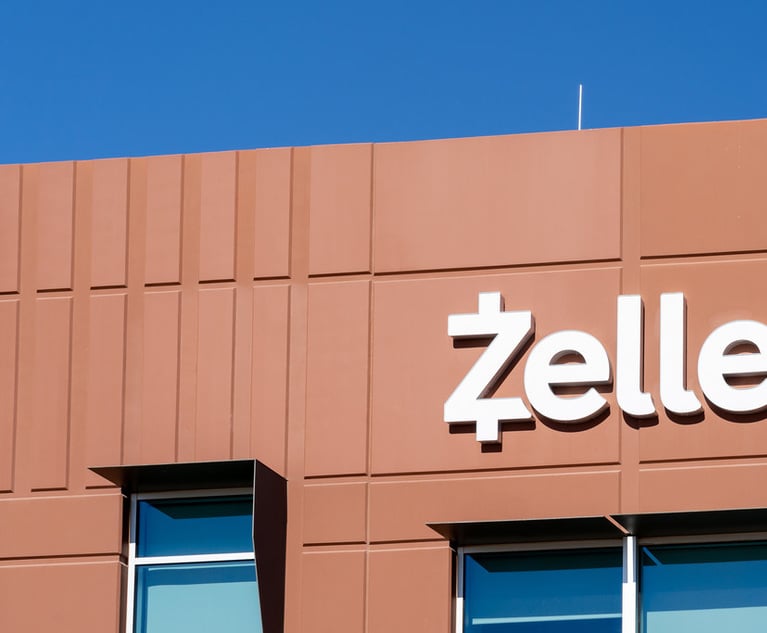Regulatory: Energy Regulation Under the Obama Administration
The administration's ambitious plan has been complicated by external events.
May 25, 2010 at 08:00 PM
6 minute read
The original version of this story was published on Law.com
 Energy and environmental rules make up a large share of the total cost of federal regulation. Because of this, government regulation of energy sources and the pollution they generate create powerful economic incentives–and disincentives–that drive business choices among competing fuels and power generation methods.
Energy and environmental rules make up a large share of the total cost of federal regulation. Because of this, government regulation of energy sources and the pollution they generate create powerful economic incentives–and disincentives–that drive business choices among competing fuels and power generation methods.
The Obama Administration has launched a major initiative intended to reshape the mix of fuels that power the American economy. It has chosen to follow an indirect approach of subsidies and regulations, rather than more visible and less popular direct energy or carbon taxes. However, implementation of this plan has been complicated by other government actions and external events.
The 2009 stimulus bill provided the Department of Energy (DOE) with billions of dollars to support alternative energy projects. Its first funding initiative was to provide $1.37 billion in loan commitments for construction of three large solar plants in the Mojave Desert. If successful, the project will generate 400 megawatts of electricity, nearly doubling the nation's existing solar power output. Ironically, the DOE's ability to fund this and other alternative energy projects has been slowed by its lack of expertise in conducting the environmental assessments required before major federal actions can be taken.
DOE also has committed $8.33 billion in loan guarantees for two new generation nuclear reactors. If built, the project will be the first commercial nuclear power plant constructed in the U.S. in 30 years. However, the administration has abandoned plans to store radioactive waste created by nuclear electric generating plants in the Yucca Mountain facility. Without a disposal policy, the role of nuclear power in meeting the country's energy needs will remain compromised.
The administration also has approved the construction of the country's first offshore wind farm near Cape Cod. It will serve as a major test of the role offshore wind turbines can play in meeting the country's energy needs.
In March, President Obama announced that he would seek legislation to open vast areas of the Outer Continental Shelf off the east coast, in the eastern Gulf of Mexico, and in the Arctic Ocean north of Alaska to oil and gas exploration. However, the Deepwater Horizon oil spill off Louisiana has clouded the prospects for expanded domestic production.
In sum, the Administration's energy strategy is to promote all alternatives to coal simultaneously, to identify which alternative or sustainable fuels can make a meaningful difference and to avoid having to make difficult technical, economic and political choices among competing energy sources.
John F. Cooney is a partner in the Washington, D.C., office of Venable.
Read John Cooney's previous column. Read John Cooney's next column.
 Energy and environmental rules make up a large share of the total cost of federal regulation. Because of this, government regulation of energy sources and the pollution they generate create powerful economic incentives–and disincentives–that drive business choices among competing fuels and power generation methods.
Energy and environmental rules make up a large share of the total cost of federal regulation. Because of this, government regulation of energy sources and the pollution they generate create powerful economic incentives–and disincentives–that drive business choices among competing fuels and power generation methods.
The Obama Administration has launched a major initiative intended to reshape the mix of fuels that power the American economy. It has chosen to follow an indirect approach of subsidies and regulations, rather than more visible and less popular direct energy or carbon taxes. However, implementation of this plan has been complicated by other government actions and external events.
The 2009 stimulus bill provided the Department of Energy (DOE) with billions of dollars to support alternative energy projects. Its first funding initiative was to provide $1.37 billion in loan commitments for construction of three large solar plants in the Mojave Desert. If successful, the project will generate 400 megawatts of electricity, nearly doubling the nation's existing solar power output. Ironically, the DOE's ability to fund this and other alternative energy projects has been slowed by its lack of expertise in conducting the environmental assessments required before major federal actions can be taken.
DOE also has committed $8.33 billion in loan guarantees for two new generation nuclear reactors. If built, the project will be the first commercial nuclear power plant constructed in the U.S. in 30 years. However, the administration has abandoned plans to store radioactive waste created by nuclear electric generating plants in the Yucca Mountain facility. Without a disposal policy, the role of nuclear power in meeting the country's energy needs will remain compromised.
The administration also has approved the construction of the country's first offshore wind farm near Cape Cod. It will serve as a major test of the role offshore wind turbines can play in meeting the country's energy needs.
In March, President Obama announced that he would seek legislation to open vast areas of the Outer Continental Shelf off the east coast, in the eastern Gulf of Mexico, and in the Arctic Ocean north of Alaska to oil and gas exploration. However, the Deepwater Horizon oil spill off Louisiana has clouded the prospects for expanded domestic production.
In sum, the Administration's energy strategy is to promote all alternatives to coal simultaneously, to identify which alternative or sustainable fuels can make a meaningful difference and to avoid having to make difficult technical, economic and political choices among competing energy sources.
John F. Cooney is a partner in the Washington, D.C., office of
Read John Cooney's previous column. Read John Cooney's next column.
This content has been archived. It is available through our partners, LexisNexis® and Bloomberg Law.
To view this content, please continue to their sites.
Not a Lexis Subscriber?
Subscribe Now
Not a Bloomberg Law Subscriber?
Subscribe Now
NOT FOR REPRINT
© 2025 ALM Global, LLC, All Rights Reserved. Request academic re-use from www.copyright.com. All other uses, submit a request to [email protected]. For more information visit Asset & Logo Licensing.
You Might Like
View All

Coinbase Hit With Antitrust Suit That Seeks to Change How Crypto Exchanges Operate
3 minute read
Baker Botts' Biopharma Client Sues Former In-House Attorney, Others Alleging Extortion Scheme
Trending Stories
- 1The Importance of Contractual Language in Analyzing Post-Closing Earnout Disputes
- 2People in the News—Jan. 8, 2025—Stevens & Lee, Ogletree Deakins
- 3How I Made Partner: 'Avoid Getting Stuck in a Moment,' Says Federico Cuadra Del Carmen of Baker McKenzie
- 4Legal Departments Dinged for Acquiescing to Rate Hikes That 'Defy Gravity'
- 5Spalding Jurors Return $12M Verdict Against State Farm Insurance Client
Who Got The Work
Michael G. Bongiorno, Andrew Scott Dulberg and Elizabeth E. Driscoll from Wilmer Cutler Pickering Hale and Dorr have stepped in to represent Symbotic Inc., an A.I.-enabled technology platform that focuses on increasing supply chain efficiency, and other defendants in a pending shareholder derivative lawsuit. The case, filed Oct. 2 in Massachusetts District Court by the Brown Law Firm on behalf of Stephen Austen, accuses certain officers and directors of misleading investors in regard to Symbotic's potential for margin growth by failing to disclose that the company was not equipped to timely deploy its systems or manage expenses through project delays. The case, assigned to U.S. District Judge Nathaniel M. Gorton, is 1:24-cv-12522, Austen v. Cohen et al.
Who Got The Work
Edmund Polubinski and Marie Killmond of Davis Polk & Wardwell have entered appearances for data platform software development company MongoDB and other defendants in a pending shareholder derivative lawsuit. The action, filed Oct. 7 in New York Southern District Court by the Brown Law Firm, accuses the company's directors and/or officers of falsely expressing confidence in the company’s restructuring of its sales incentive plan and downplaying the severity of decreases in its upfront commitments. The case is 1:24-cv-07594, Roy v. Ittycheria et al.
Who Got The Work
Amy O. Bruchs and Kurt F. Ellison of Michael Best & Friedrich have entered appearances for Epic Systems Corp. in a pending employment discrimination lawsuit. The suit was filed Sept. 7 in Wisconsin Western District Court by Levine Eisberner LLC and Siri & Glimstad on behalf of a project manager who claims that he was wrongfully terminated after applying for a religious exemption to the defendant's COVID-19 vaccine mandate. The case, assigned to U.S. Magistrate Judge Anita Marie Boor, is 3:24-cv-00630, Secker, Nathan v. Epic Systems Corporation.
Who Got The Work
David X. Sullivan, Thomas J. Finn and Gregory A. Hall from McCarter & English have entered appearances for Sunrun Installation Services in a pending civil rights lawsuit. The complaint was filed Sept. 4 in Connecticut District Court by attorney Robert M. Berke on behalf of former employee George Edward Steins, who was arrested and charged with employing an unregistered home improvement salesperson. The complaint alleges that had Sunrun informed the Connecticut Department of Consumer Protection that the plaintiff's employment had ended in 2017 and that he no longer held Sunrun's home improvement contractor license, he would not have been hit with charges, which were dismissed in May 2024. The case, assigned to U.S. District Judge Jeffrey A. Meyer, is 3:24-cv-01423, Steins v. Sunrun, Inc. et al.
Who Got The Work
Greenberg Traurig shareholder Joshua L. Raskin has entered an appearance for boohoo.com UK Ltd. in a pending patent infringement lawsuit. The suit, filed Sept. 3 in Texas Eastern District Court by Rozier Hardt McDonough on behalf of Alto Dynamics, asserts five patents related to an online shopping platform. The case, assigned to U.S. District Judge Rodney Gilstrap, is 2:24-cv-00719, Alto Dynamics, LLC v. boohoo.com UK Limited.
Featured Firms
Law Offices of Gary Martin Hays & Associates, P.C.
(470) 294-1674
Law Offices of Mark E. Salomone
(857) 444-6468
Smith & Hassler
(713) 739-1250







